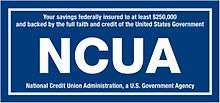National Credit Union Administration
The National Credit Union Administration (NCUA) is one of two agencies that provide deposit insurance to depositors in U.S. depository institutions, the other being the Federal Deposit Insurance Corporation, which insures commercial banks and savings institutions. The NCUA is an independent federal agency created by the United States Congress to regulate, charter, and supervise federal credit unions. With the backing of the full faith and credit of the U.S. government, the NCUA operates and manages the National Credit Union Share Insurance Fund, insuring the deposits of more than 111 million account holders in all federal credit unions and the overwhelming majority of state-chartered credit unions. As of September 2016, there were 5,573 federally insured credit unions, with assets totaling more than $1.38 trillion, and net loans of $957.3 billion.[4] The NCUA exclusively insures credit unions, whereas commercial banks and savings institutions are insured by the Federal Deposit Insurance Corporation.
 Official seal | |
| Agency overview | |
|---|---|
| Formed | March 10, 1970 |
| Preceding agency | |
| Jurisdiction | Federal government of the United States |
| Headquarters | Alexandria, Virginia |
| Employees | 1,224 (2015)[1] |
| Annual budget | $298.2 million (2018)[2] |
| Agency executives |
|
| Website | www |
| This article is part of a series on |
| Banking in the United States |
|---|
|
|
Lending |
|
Payment and transfer |
|
United States portal |
Organization
The NCUA is governed by a three-member board appointed by the President of the United States and confirmed by the Senate. The President also chooses who will serve as Chairman.[5] Board members serve six-year terms, although members often remain until their successors are confirmed and sworn in.[5]
The NCUA is administered through three regional offices, each responsible for specific states and territories.[2]
| Region | Headquarters | States/territories |
|---|---|---|
| Eastern Region | Alexandria, VA | Connecticut, Delaware, the District of Columbia, Maine, Maryland, Massachusetts, Michigan, New Hampshire, New Jersey, New York, Ohio, Pennsylvania, Rhode Island, Vermont, Virginia, and West Virginia. |
| Southern Region | Austin, TX | Alabama, Arkansas, Florida, Georgia, Indiana, Kentucky, Louisiana, Mississippi, North Carolina, Oklahoma, Puerto Rico, South Carolina, Tennessee, Texas, and the U.S. Virgin Islands. |
| Western Region | Tempe, AZ | Alaska, Arizona, California, Colorado, Guam, Hawaii, Idaho, Illinois, Iowa, Kansas, Minnesota, Missouri, Montana, Nebraska, Nevada, New Mexico, North Dakota, Oregon, South Dakota, Utah, Washington, Wisconsin, and Wyoming. |
History
As part of the New Deal, President Franklin D. Roosevelt signed the Federal Credit Union Act into law in 1934. The law allowed the chartering of federal credit unions in all states. The federal law sought to make credit available and promote thrift through a national system of nonprofit, cooperative credit.
At first, the newly created Bureau of Federal Credit Unions was housed at the Farm Credit Administration. Regulatory responsibility shifted over the years as the bureau migrated from the Federal Deposit Insurance Corporation to the Federal Security Agency, then to the Department of Health, Education, and Welfare.
In the 1940s and 1950s, credit unions grew steadily, reaching a membership of more than six million people at over 10,000 federal credit unions by 1960.
1970s

The growth in credit unions resulted in an overhauling of the Bureau of Federal Credit Unions to form the modern independent federal agency that presently regulates the industry.
In 1970, the renaming to National Credit Union Administration was made possible in part by the creation of the National Credit Union Share Insurance Fund (NCUSIF) to insure credit union deposits. The NCUSIF was created without any tax dollars, capitalized solely by credit unions.[6]
By 1977, services available to credit union members expanded, including share certificates and mortgage lending. In 1979, a three-member Board replaced the NCUA administrator. Congress added the finishing touches to this new administration with the addition of the Central Liquidity Facility, the lender of last resort for all credit unions.
The decade of the 1970s saw substantial growth for existing credit unions, with membership doubling and assets tripling to over $65 billion.
1980s and 1990s
The high interest rates and unemployment in the early 1980s brought insurance losses. The NCUSIF experienced strain, and credit unions lobbied Congress to recapitalize the Fund. In 1985, the plan became law, and federally insured credit unions recapitalized the NCUSIF by depositing 1 percent of their shares into the NCUSIF. The fully capitalized National Credit Union Share Insurance Fund has "fail safe" features. In 1991, when equity level dipped below 1.23 percent, the Board charged credit unions a premium to insure deposits. The enhancement of member services in the 1980s accompanied deregulation and increased flexibility in merger and field of membership criteria. Previously, membership in credit unions was generally limited to select groups with a pre-existing common bond, often employees of a particular company or trade. Changes since 1998 as a result of H.R. 1151, the Credit Union Membership Access Act, opened up membership eligibility to include much larger and loosely defined groups.[7]
During the 1990s and into the 21st century, credit unions grew steadily in assets, shares and members. Failures remained generally low, and the Share Insurance Fund maintained a healthy equity level.
2000 and beyond
During the 1990s and into the beginning of the 21st century, U.S. credit unions continued to develop as a whole. The NCUSIF also continued to thrive due to very few credit union failures. In 2008 and 2009, the global financial crisis exerted a strain on all institutions in the financial services sector – including credit unions. As a result, the Board charged NCUSIF premiums in 2009 and 2010.
Ultimately, five of the largest wholesale corporate credit unions (Constitution Corporate, Members United Corporate, Western Corporate, Southwest Corporate, and U.S. Central Corporate) in the United States were rendered insolvent after investing in troubled mortgage-backed securities that became overwhelmed with unprecedented declines in value.
In response to the growing corporate credit union crisis, the NCUA took the following actions:
- Collaborated with the U.S. Treasury Department and Congress to establish the Temporary Corporate Credit Union Stabilization Fund (Stabilization Fund) to stabilize the U.S. credit unions, protect the NCUSIF and ensured credit unions, not taxpayers, paid the costs of the Stabilization Fund over time.
- Re-securitized the unsuccessful mortgage backed securities after liquidating the five failed corporate credit unions. With a government-backed guarantee, the securities were sold to raise nearly $30 billion.
- A temporary share guarantee was established for deposits at corporate credit unions.
- Bridge corporate credit unions were established to ensure services continued to be provided to consumer credit unions during the transition and resolution timeframe.
- Worked together with bridge corporate credit union members and to ensure a seamless transition of services to new entities.
In addition to the corporate credit union crisis, the NCUA dealt with the failure of a number of consumer-owned credit unions, which weakened as a result of spikes in home foreclosures, business failures, and unemployment.
To protect against the failure of more credit unions, the NCUA implemented a 12-month examination cycle for federally insured credit unions to detect problems in individual credit unions before they became insurmountable. NCUA also stepped up administrative actions wherever necessary to ensure prompt compliance. By year-end 2009, more than 96 percent of credit unions met the statutory definition of "well capitalized."[8]
On December 8, 2017, President Donald Trump issued an executive order revising the Seal for the National Credit Union Administration.[9][10]
Read more at the NCUA's Historical Timeline.
Regulatory modernization
After five years focused on strengthening the regulatory framework to withstand another crisis, the NCUA shifted focus in 2015 toward regulatory relief. During the year, the NCUA finalized or proposed 15 modernized regulations to reduce compliance burdens or authorize new powers. Touching key stakeholder concerns, these initiatives removed outdated procedures and non-statutory requirements. They also gave credit unions greater flexibility to make decisions and serve their members’ needs.[11]
Insurance coverage

The National Credit Union Share Insurance Fund (NCUSIF) is the federal fund created by the United States Congress in 1970 to insure members' deposits in federally insured credit unions. On July 22, 2010, the Dodd-Frank Wall Street Reform and Consumer Protection Act was signed into law and included permanently establishing NCUA's standard maximum share insurance amount at $250,000. The NCUA operates and manages the NCUSIF, insuring the deposits of more than 111 million account holders in all federal credit unions and the overwhelming majority of state-chartered credit unions.[12]
Credit unions may also offer an array of additional financial services which are not covered by federal insurance.
Websites
On March 9, 2011, then Board Chairman Debbie Matz unveiled MyCreditUnion.gov, a source of educational information and personal finance tips designed to help individuals make financial decisions. The website also explains how credit unions work, where to find one, and even how to start a credit union.[13]
See also
- Title 12 of the Code of Federal Regulations
- Credit Union National Association
- NCUA Corporate Stabilization Program
- NCUA v. First National Bank & Trust
References
- https://www.ncua.gov/About/Pages/budget-strategic-planning/supplementary-materials.aspx
- "NCUA Budget and Supplementary Materials".
- "President Trump Designates Rodney Hood Chairman Of NCUA Board" (Press release). National Credit Union Administration. April 9, 2019. Retrieved 2019-04-10.
- NCUA. Industry at a Glance.
- Mark, Claude R. (2008-07-03). "Johnson to Stay in NCUA Chairmanship till August". Credit Union Times. Highline Media. Archived from the original on 2008-08-21. Retrieved 2008-07-07.
- "A Brief History of Credit Unions". National Credit Union Administration. February 25, 2013. Missing or empty
|url=(help) - "The 6 Months That Changed Everything". Credit Union Journal. XVII (8): 15–19. February 25, 2013.
- "retrieved on June 25, 2012". Ncua.gov. Retrieved 2012-12-22.
- Office of the Press Secretary (December 8, 2017). "Presidential Executive Order on Revising the Seal for the National Credit Union Administration". whitehouse.gov. Washington, D.C.: White House. Retrieved December 10, 2017.
- "Executive Orders Passed under the Trump Administration". InsideGov. United States: Graphiq. December 8, 2017. Retrieved December 10, 2017.
- "retrieved on September 20, 2015" (PDF). Ncua.gov. Retrieved 2015-10-11.
- "Share Insurance Overview". NCUA.gov. Retrieved December 22, 2012.
- "Matz Launches NCUA's Mycreditunion.gov" (PDF). National Credit Union Administration. Retrieved 2011-03-09.